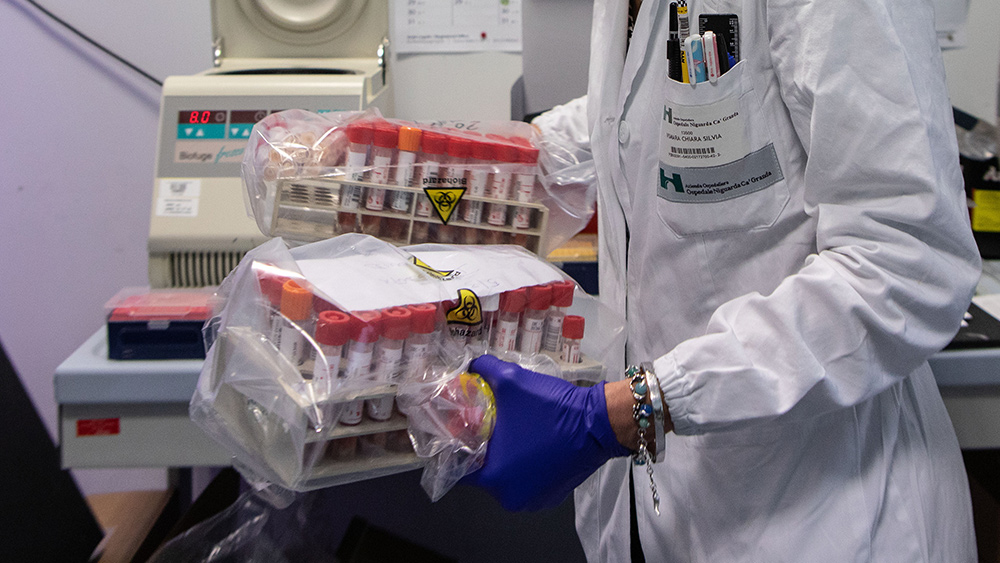Official documents reveal scientists sent dangerous viral DNA samples to Wuhan lab before the pandemic
11/24/2021 / By Zoey Sky

Leaked documents revealed that scientists at the Wuhan Institute of Virology (WIV) were already studying the dangerous coronaviruses in high-risk bat species from Laos years before the Wuhan coronavirus (COVID-19) pandemic began.
The documents suggest that “both the bat origin theory of the COVID-19 pandemic and the lab-leak theory could be simultaneously true.”
Back in September, researchers stumbled upon Banal-52, a coronavirus strain in Laos. Banal-52 shares a 96.8 percent genomic similarity with SARS-CoV-2, the viral strain that causes COVID-19, hinting that the two may be related.
Documents suggest Wuhan lab received viral samples from Laos
Some claim that the discovery of Banal-52 and its similarity with SARS-CoV-2 confirms hypotheses that the source of the pandemic was a natural spillover instead of a lab escape.
However, leaked emails between EcoHealth Alliance and U.S. government funders shed some light on how Banal-52 became SARS-CoV-2 in Wuhan, which is more than a thousand miles away from Laos.
The documents were obtained by the White Coat Waste Project, a U.S.-based bipartisan group that got the emails through a Freedom of Information Request.
According to the emails, between June 2017 and May 2019, the WIV received viral samples of “bats and other high-risk species” from Laos. Before Banal-52 was discovered, the EcoHealth Alliance was studying other bat viruses, including some from Yunnan, China, and sending them to WIV.
The samples included RaTG13, another strain that’s genetically similar to SARS-CoV-2. RaTG13 was first discovered in a horseshoe bat in a Yunnan mineshaft. The Chinese government denied researchers access to the animal subject.
Reports say that data on the genetic sequences of the samples collected from both Laos and Yunnan were cleared from an online database at the WIV, where they were stored until September 2019. Because the data was cleared, researchers are now unable to accurately determine what strains the WIV studied.
COVID-19 could have started in Laos, not China
Gilles Demaneuf, a New Zealand-based data scientist and pandemic origins researcher, suggests that the leaked documents’ revelations offer a “plausible” route to trace the virus’s spread from bats in Laos to Wuhan.
In a blog post, Demaneuf wrote that the documents hint at “a very plausible direct route with two options.”
Viscount Matt Ridley, co-author of the book “Viral: The Search for the Origin of COVID-19,” also believes the leaked emails do more than support the lab-leak theory. He doesn’t consider Banal-52 as the progenitor of the disease, but it still suggests that COVID-19 could have originated in Laos, not China.
In an interview, Ridley explained that the document leak showed how the EcoHealth Alliance was sampling bats in Laos. The document also revealed that it would be difficult to return and ask the U.S. government for permission to give some of the grant to a Laotian lab, so the group asked if they could forward all the samples to a lab that can analyze them.
The lab referred to was the one in Wuhan and the outbreak happened in a city with the world’s largest research program on bat-borne coronaviruses. The location was also close to where researchers in Wuhan could have tried to trace the origins of viruses similar to SARS-CoV-2. (Related: Documents and videos reveal life-threatening adverse effects of COVID-19 vaccines.)
Study of SARS-like viruses could have continued without US funding
Ridley suggested two possibilities: First, a Wuhan bat sampler was infected on a field sampling trip; second, a research accident in Wuhan occurred when scientists were “manipulating a Laos Banal-like bat coronavirus.”
Data from another leaked document accessed by Drastic, an open-source data analyst group, showed that EcoHealth Alliance President Dr. Peter Daszak had suggested that the U.S. government fund the artificial insertion of “cleavage sites into SARS-like coronaviruses collected in the field and studied in Wuhan.”
The document includes a plan to study potentially dangerous pathogens by “generating full-length, infectious bat coronaviruses in a lab and inserting genetic features that could make coronaviruses better able to infect human cells.”
In 2018, the U.S. government declined Daszak’s request for $14.2 million due to worries about the impact of the organization’s virus alteration work. Ridley thinks that the work still proceeded even though the U.S. turned down his request.
Most of the funding for the WIV comes from the Chinese government, not the American government. Ridley believes this could explain how the work Daszak proposed could have continued without the funding he requested in 2018.
The lab-leak theory also seems reasonable despite the naysayers because a similar experiment had already been done with a different kind of coronavirus by the WIV, said Ridley.
Go to Pandemic.news for more articles about the origins of COVID-19.
Sources include:
Submit a correction >>
Tagged Under:
big government, China, conspiracy, covid-19 pandemic, dangerous experiments, EcoHealth Alliance, lab-leak theory, Laos, lies, Plandemic, science deception, science fraud, virus research, Wuhan coronavirus, Wuhan Institute of Virology
This article may contain statements that reflect the opinion of the author
RECENT NEWS & ARTICLES
SpikeProtein.news is a fact-based public education website published by SpikeProtein News Features, LLC.
All content copyright © 2021 by SpikeProtein News Features, LLC.
Contact Us with Tips or Corrections
All trademarks, registered trademarks and servicemarks mentioned on this site are the property of their respective owners.





















